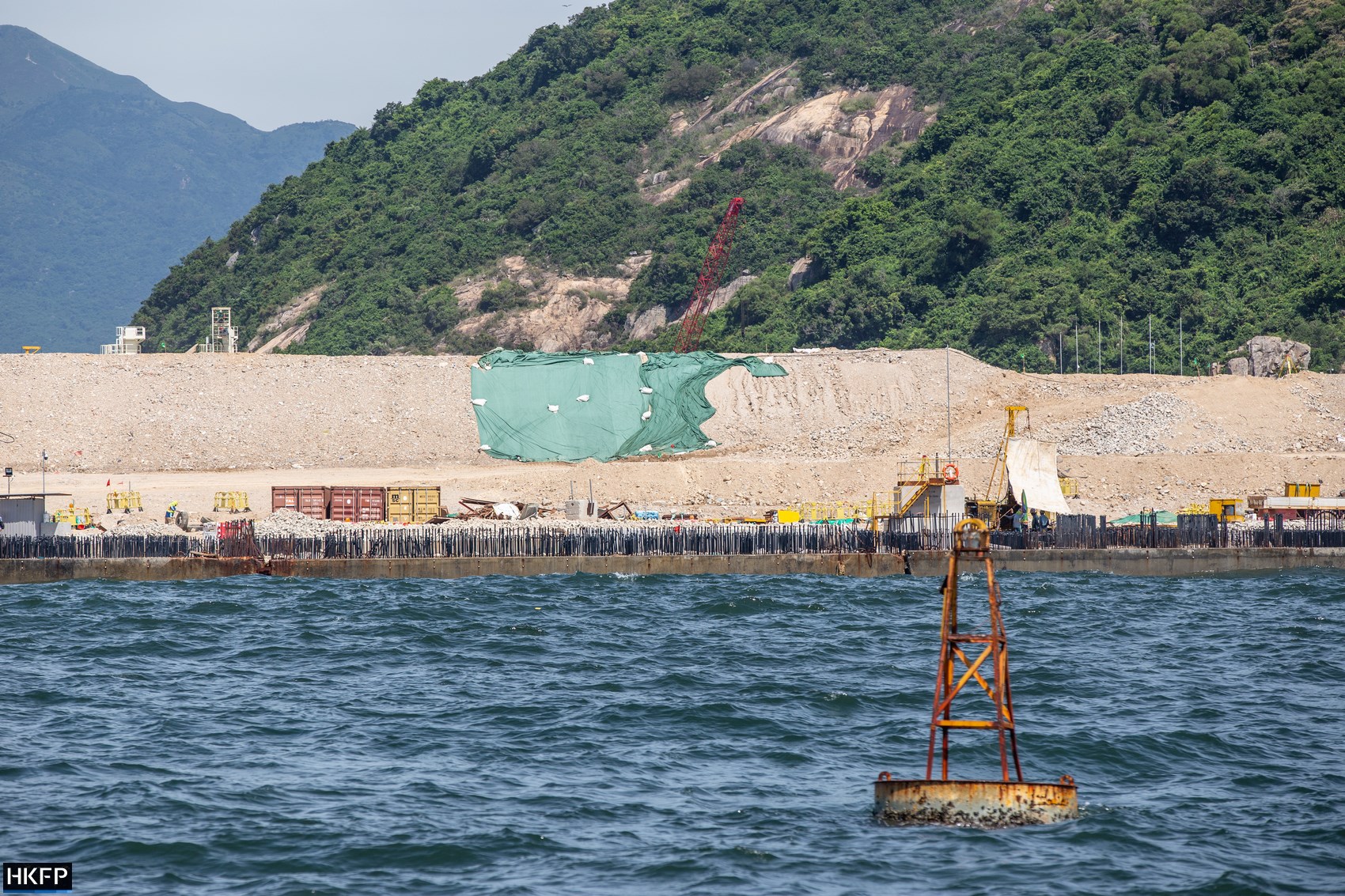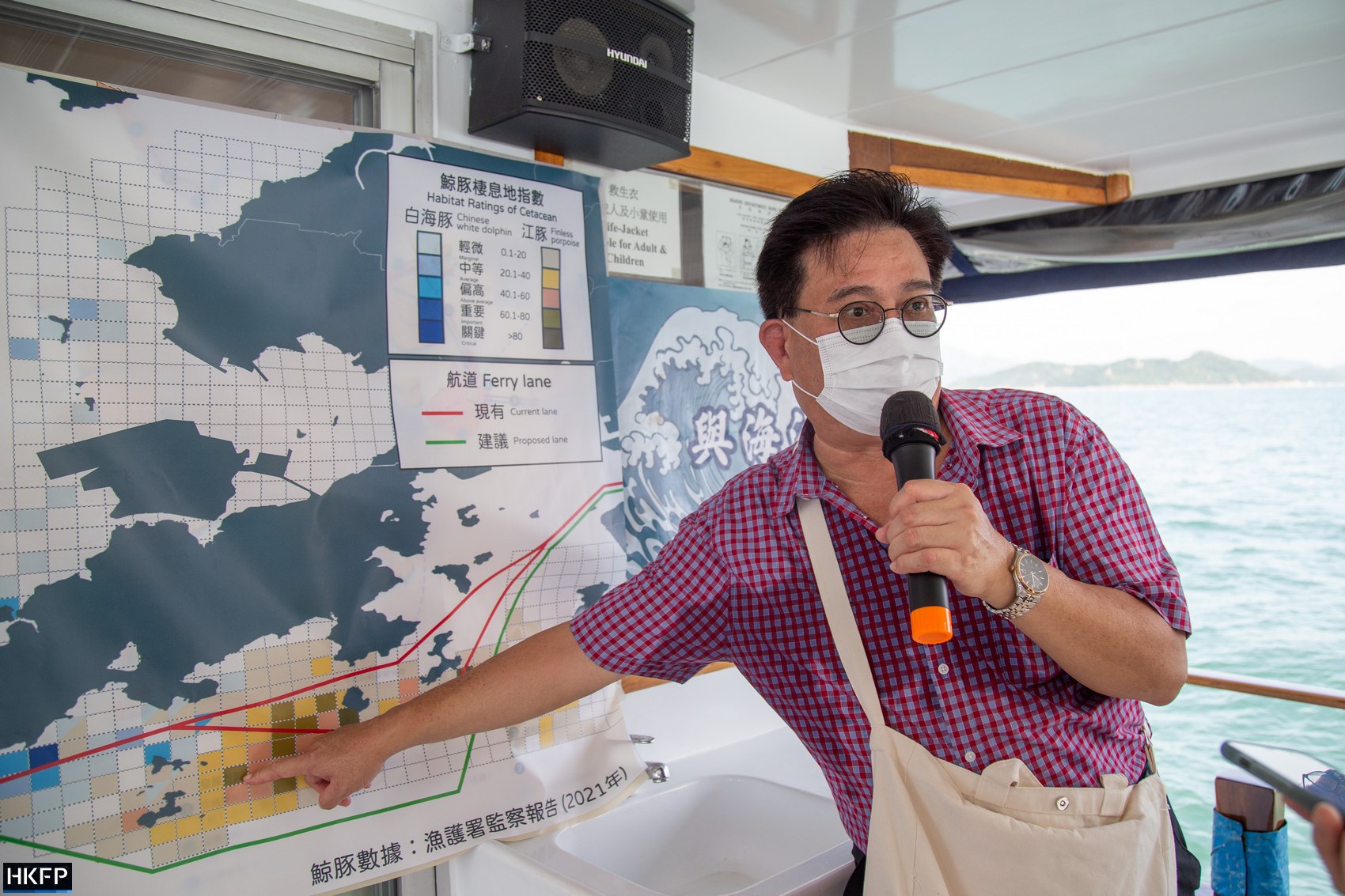Vulnerable finless porpoise in Hong Kong may be driven away from their “favourite habitat” by construction work for an incinerator off southern Lantau, local green groups have warned. The concerns came as the government is set to allow work on four submarine cables to take place during the marine mammals’ peak season, despite such timing being banned by the project’s original environmental permit.

Close to the restricted island of Shek Kwu Chau, off the south Lantau coast, a bustling construction site with excavators and bulldozers stands in stark contrast to the nearby serene islands. Last Friday, HKFP observed the reclamation work from a distance on an inspection boat trip with environmentalists from WWF-Hong Kong, the Hong Kong Dolphin Conservation Society and the Save Lantau Alliance.
The 16-hectare artificial island will become the site of the government’s controversial Integrated Waste Management Facilities (IWMF) project. The facility – with the first phase expected to come into operation in 2025 – aims at easing the burden of the city’s landfills by treating 3,000 tonnes of waste a day, using incineration as the core technology.

Peak season
Although local conservationist groups had failed to avert the building of the incinerator site in a “critical habitat” of the Indo-Pacific finless porpoises, they are seeking to protect the rare species from enduring more construction work around the Shek Kwu Chau area.

Doris Woo, a conservation officer at WWF-Hong Kong, said last Friday that environmentalists were alarmed when the government announced in July that it intended to allow CLP Power Hong Kong to begin installing submarine cables to supply electricity for the incinerator in late 2023, including between December to May, when finless porpoise would be most frequently sighted.

The building of four cables – covering more than 7,300 square metres of foreshore and seabed from Cheung Sha to the artificial island – was approved by the Environmental Protection Department (EPD) back in January 2012. An original environmental permit had required the electricity company to limit construction work to between June and November, in order to avoid a clash with the peak season of finless porpoise gatherings. But the restriction was removed in an amended permit issued in May last year, a decision which environmentalists slammed as as violation of mitigation protocols.
“For every project proponent, they will first have to avoid any unnecessary construction impacts before they seek ways to mitigate them… we think they are acting against all these guidelines,” Woo said.

Swimmers prioritised
In response to HKFP enquiries, the EPD said on Monday that the permit amendment was “necessary” to meet CLP’s new construction schedule. The firm previously suggested relocating the cable landing site away from a natural rocky shore “to reduce potential ecological impact.” But the new route would have landed at Cheung Sha beach, meaning the electricity firm had to revise its construction programme to avoid affecting swimmers, the EPD said.

A spokesperson for CLP said they were aware that its construction plan would “inevitably clash” with the peak season of the finless porpoise, which are similar in appearance to dolphins but are more closely related to belugas and narwhals. They are protected under the Wild Animals Protection Ordinance.

As mitigation, the power company pledged to prioritise installation work at Shek Kwu Chau before the commencement of the peak season. It would also keep the construction noise to a frequency lower than that used by finless porpoise in foraging and communication.
Other proposed policies to reduce the impact of the work included setting up an “exclusion zone,” which would alert workers to stop the construction if marine mammals were detected in the area. Jetting works would also be restricted to day time only, while a speed limit would be imposed on construction vessels.

“CLP Power attaches great importance to the marine ecological and environmental conservation. We have therefore consulted professional consultant for assessing impacts to marine ecology and made reference to research materials,” the firm said.
But CLP’s precautionary measures were deemed insufficient by Woo and Viena Mak, vice-chair of the dolphin conservation society. They both said the mere presence of the working vessels could “repel” finless porpoise from Shek Kwu Chau’s waters.

“Given the porpoise is a very shy and sensitive animal… the occurrence of [construction vessels] can actually scare the animal away and cause them to avoid or even abandon the area originally frequented by the animal,” the WWF-Hong Kong representative said.
Permit ‘loophole’
According to a study conducted by Hong Kong marine biologist Samuel Hung, a total of 226 finless porpoises were sighted in the city’s waters between April 1 last year and March 31 this year. Hung’s report suggested the construction of the waste management facilities may be linked to the “notable” decline in usage of Shek Kwu Chau as a finless porpoises habitat since 2018.

Woo said the lack of any official public consultation on the amendments to environmental permits was a “loophole” that should be addressed by the government. She said that, currently, there were very few channels for members of the public to lodge complaints against permit amendments deemed “unfavourable” to the environment.
Mak agreed, saying that environmentalists should be consulted to improve the transparency of the decision-making process: “It is very hard for the public to trace what was changed [in the permit] and what was happening. It is not transparent.”

Activist Woo also expressed fears that the CLP case would set a precedent for other project proposals, as they demand changes to their permit after filing a “perfect environmental impact assessment” (EIA) before work begins.
“We fear that project proponents will take this kind of loophole… to not adhere to too many marine conservation requirements, or to implement the promised measures that they stated in the EIA,” she said.

In a written reply to the Islands District Councillor Eric Kwok Ping, who raised questions on the submarine cables installation in a meeting n Monday, the Lands Department said it will give the green light to the proposed construction if no written objection is received on or before September 30. The department had asked people who believed they have “an interest, right or easement in or over the foreshore and seabed involved” to describe how they will be allegedly affected as part of their objection.

A spokesperson for CLP, on the other hand, said they met with representatives of environmental groups and local community leaders prior to applying for a change in the environmental permit. The company said their views were “collected,” without specifying what kind of feedback they received.
Woo and Mak responded by saying their colleagues had only “informal lunch meetings” with CLP. They said the company did not conduct a “formal consultation” on the amendments to the cable installation permit.

Asked if a large-scale consultations may delay the start of a construction project, Woo said she believed project organisers should have considered the relevant time cost, rather than trying to rush its construction timeline.
Mak urged the government to act as a “gatekeeper” and preserve the “unique habitat” that southern Lantau offers to finless porpoise by applying a “precautionary principle” in reviewing any change to the environmental permit.

“It is difficult to recreate a habitat and then [tell] the finless porpoise that we have another designated area for you… this favourable habitat for dolphins and finless porpoise is very unique. If we destroy them, temporarily or permanently, it could be disastrous for the population,” she said.
Support HKFP | Policies & Ethics | Error/typo? | Contact Us | Newsletter | Transparency & Annual Report | Apps
Help safeguard press freedom & keep HKFP free for all readers by supporting our team

LATEST FROM HKFP
HKFP has an impartial stance, transparent funding, and balanced coverage guided by an Ethics Code and Corrections Policy.
Support press freedom & help us surpass 1,000 monthly Patrons: 100% independent, governed by an ethics code & not-for-profit.










